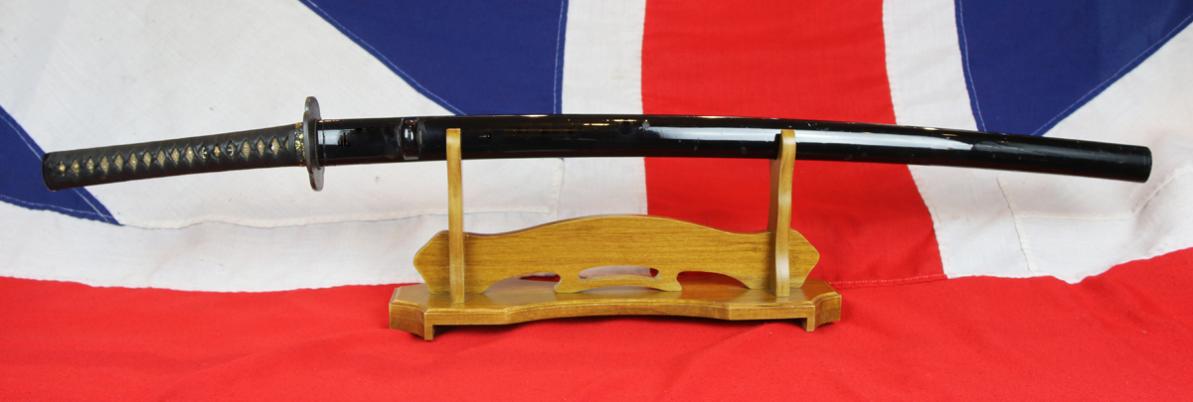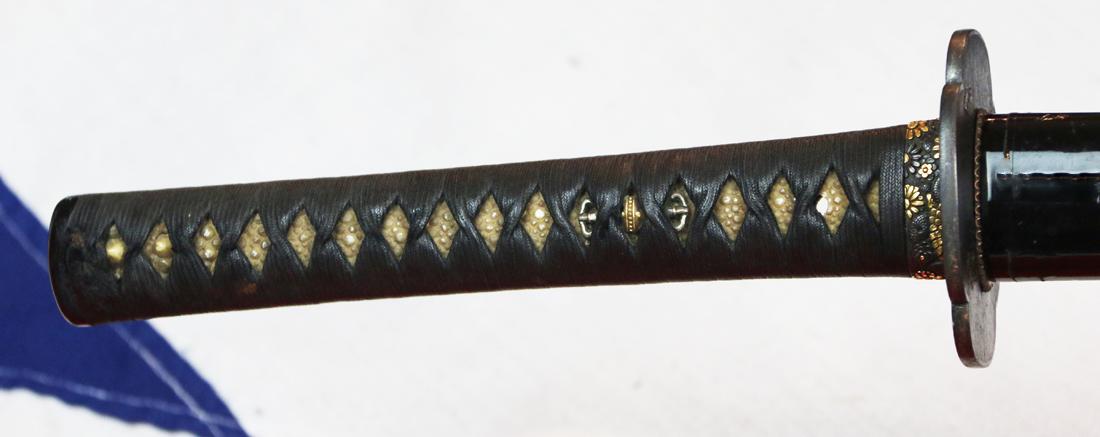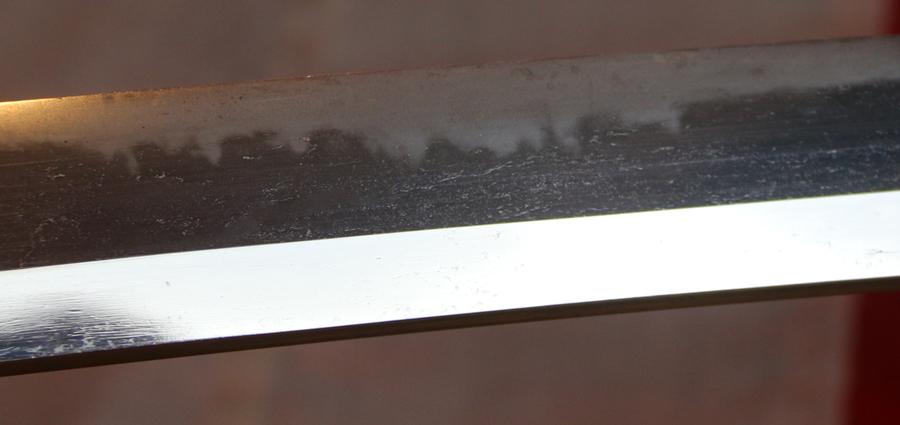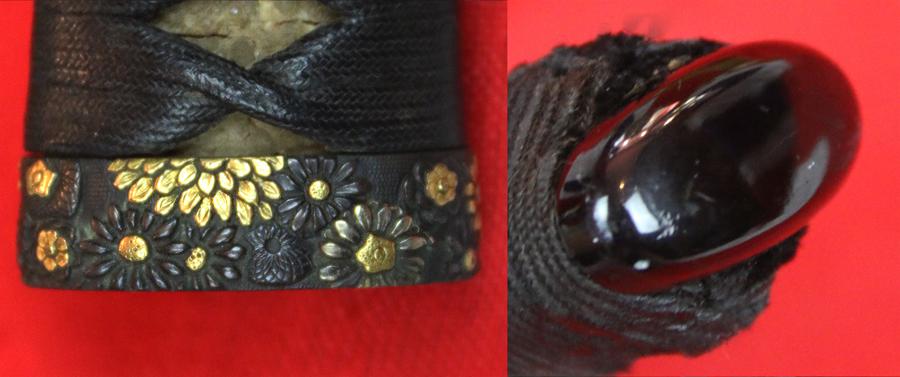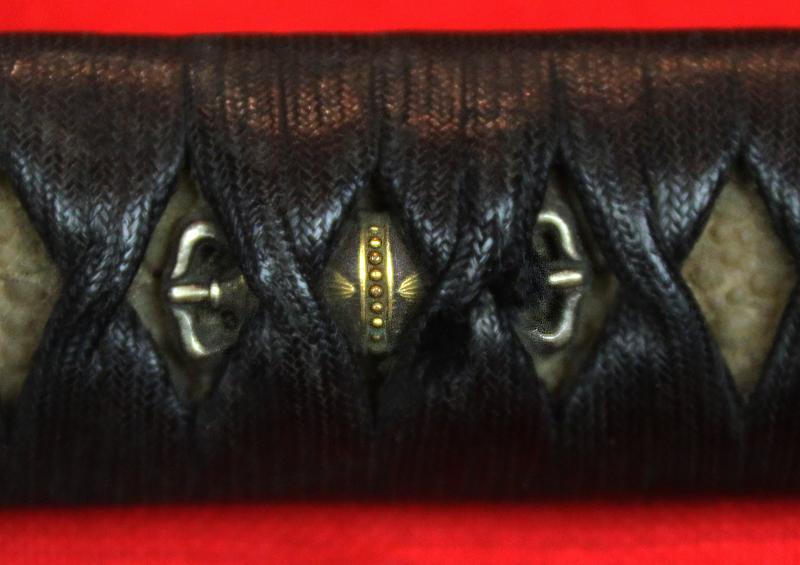SOLD A Superb Koto Period Combat Katana Circa 1530
This is a true battle sword, with delightful fine quality fittings but no unnecessary frills. This is the katana combat sword of a high ranking samurai, way above the grade of a foot soldier samurai. The tsuba is shakudo of a nanako ground and four mon the 5 leaf ivy [tsuta mon] of the Matsunaga clan. The Matsunaga clan that follows the lineage of Matsunaga Danjo Hisahide (松永弾正久秀) is the most famous in Japan. Hisahida was the daimyō of the Yamato Province during the Sengoku period. He was born in the year of 1508 and shares the same roots with the Fujiwara clan as the Matsunaga clan in the Mikawa Province. They both used the same tsuta-mon (ivy) as their family crest. In Japan, when people think of the Matsunaga clan, it is usually Hisahide they are referring to.
Hisahide served as the main retainer for Miyoshi Nagayoshi of the Miyoshi clan in the Yamato Province. He also served as retainer briefly for the Oda clan.
Hisahide’s actual title was Danjo Shohitsu (弾正少弼) which was positioned under the vice minister of Danjo with the Senior Fourth Rank, Lower Grade. He would become the daimyō of the Yamato Province.
Hisahide later committed seppuku after Oda Nobunaga besieged him at Shigisan Castle in 1577. Both of his sons, Kojiro and Hisamichi (松永久通), also committed seppuku during the siege. The Matsunaga mon are in gold to both sides of the tsuba. The fushi is a very fine takebori [deep relief carved] in shakudo and gold of chrysanthemums .It has a fine polished carved buffalo horn kashira.The long tsuka [hilt] has original Edo silk binding and is wrapped over traditional giant rayskin and menuki of gold and silver Bhuddist varjira [lightning makers]. Silvered copper habaki blade collar. Black saya. This wonderful sword is around 500 years old. The blade has a superb choji hamon in around 90%+ original Edo polish. Made some decades before but certainly used in the time of the greatest battle in samurai history "The Battle of Sekigahara" [Sekigahara no Tatakai] was a decisive battle on October 21, 1600 that preceded the establishment of the Tokugawa shogunate. Initially, Tokugawa's eastern army had 75,000 men, while Ishida's western army numbered 120,000. Tokugawa had also sneaked in a supply of arquebuses. Knowing that Tokugawa was heading towards Osaka, Ishida decided to abandon his positions and marched to Sekigahara. Even though the Western forces had tremendous tactical advantages, Tokugawa had already been in contact with many daimyo in the Western Army for months, promising them land and leniency after the battle should they switch sides.
Tokugawa's forces started the battle when Fukushima Masanori, the leader of the advance guard, charged north from Tokugawa's left flank along the Fuji River against the Western Army's right centre. The ground was still muddy from the previous day's rain, so the conflict there devolved into something more primal. Tokugawa then ordered attacks from his right and his centre against the Western Army?s left in order to support Fukushima's attack.
This left the Western Army's centre unscathed, so Ishida ordered this unit under the command of Shimazu Yoshihiro to reinforce his right flank. Shimazu refused as daimyos of the day only listened to respected commanders, which Ishida was not.
Recent scholarship by Professor Yoshiji Yamasaki of Toho University has indicated that the Mori faction had reached a secret agreement with the Tokugawa two weeks earlier, pledging neutrality at the decisive battle in exchange for a guarantee of territorial preservation, and was a strategic decision on Mori Terumoto's part that later backfired.
Fukushima's attack was slowly gaining ground, but this came at the cost of exposing their flank to attack from across the Fuji River by Otani Yoshitsugu, who took advantage of this opportunity. Just past Otani's forces were those of Kobayakawa Hideaki on Mount Matsuo.
Kobayakawa was one of the daimyos that had been courted by Tokugawa. Even though he had agreed to defect to Tokugawa's side, in the actual battle he was hesitant and remained neutral. As the battle grew more intense, Tokugawa finally ordered arquebuses to fire at Kobayakawa's position on Mount Matsuo to force Kobayakawa to make his choice. At that point Kobayakawa joined the battle as a member of the Eastern Army. His forces charged ?tani's position, which did not end well for Kobayakawa. Otani's forces had dry gunpowder, so they opened fire on the turncoats, making the charge of 16,000 men mostly ineffective. However, he was already engaging forces under the command of Todo Takatora, Kyogoku Takatsugu, and Oda Yuraku when Kobayakawa charged. At this point, the buffer Otani established was outnumbered. Seeing this, Western Army generals Wakisaka Yasuharu, Ogawa Suketada, Akaza Naoyasu, and Kutsuki Mototsuna switched sides, turning the tide of battle Blade 29.25 tsuba to tip.This is a true battle sword, with delightful fine quality fittings [koshirae] but no unnecessary frills. This is the katana combat sword of a high ranking samurai, way above the grade of a foot soldier samurai. The tsuba is shakudo of a nanako ground and four mon the 5 leaf ivy [tsuta mon] of the Matsunaga clan. The blade is in nice clear polish and the blade shows just usual commensurate wear for age and use, and looks absolutely beautiful. The saya has beautiful black urushi lacquer, in superb condition, finely bound with sageo cord. The menuki under the binding are varjira [thunderbolt makers] and the fushi [hilt collar] is decorated over a nanako ground with carved chrysanthemum flowers in bronze overlaid with pure gold. The Matsunaga clan that follows the lineage of Matsunaga Danjo Hisahide (松永弾正久秀) is the most famous in Japan. Hisahida was the daimyō of the Yamato Province during the Sengoku period. He was born in the year of 1508 and shares the same roots with the Fujiwara clan as the Matsunaga clan in the Mikawa Province. They both used the same tsuta-mon (ivy) as their family crest. In Japan, when people think of the Matsunaga clan, it is usually Hisahide they are referring to.
Hisahide served as the main retainer for Miyoshi Nagayoshi of the Miyoshi clan in the Yamato Province. He also served as retainer briefly for the Oda clan.
Hisahide’s actual title was Danjo Shohitsu (弾正少弼) which was positioned under the vice minister of Danjo with the Senior Fourth Rank, Lower Grade. He would become the daimyō of the Yamato Province.
Hisahide later committed seppuku after Oda Nobunaga besieged him at Shigisan Castle in 1577. Both of his sons, Kojiro and Hisamichi (松永久通), also committed seppuku during the siege. The Matsunaga mon are in gold to both sides of the tsuba. The fushi is a very fine takebori [deep relief carved] in shakudo and gold of chrysanthemums .It has a fine polished carved buffalo horn kashira.The long tsuka [hilt] has original Edo silk binding and is wrapped over traditional giant rayskin and menuki of gold and silver Bhuddist varjira [lightning makers]. Silvered copper habaki blade collar. Black saya. This wonderful sword is around 500 years old. The blade has a superb choji hamon in around 90%+ original Edo polish. Made some decades before but certainly used in the time of the greatest battle in samurai history "The Battle of Sekigahara" [Sekigahara no Tatakai] was a decisive battle on October 21, 1600 that preceded the establishment of the Tokugawa shogunate. Initially, Tokugawa's eastern army had 75,000 men, while Ishida's western army numbered 120,000. Tokugawa had also sneaked in a supply of arquebuses. Knowing that Tokugawa was heading towards Osaka, Ishida decided to abandon his positions and marched to Sekigahara. Even though the Western forces had tremendous tactical advantages, Tokugawa had already been in contact with many daimyo in the Western Army for months, promising them land and leniency after the battle should they switch sides.
Tokugawa's forces started the battle when Fukushima Masanori, the leader of the advance guard, charged north from Tokugawa's left flank along the Fuji River against the Western Army's right centre. The ground was still muddy from the previous day's rain, so the conflict there devolved into something more primal. Tokugawa then ordered attacks from his right and his centre against the Western Army’s left in order to support Fukushima's attack.
This left the Western Army's centre unscathed, so Ishida ordered this unit under the command of Shimazu Yoshihiro to reinforce his right flank. Shimazu refused as daimyos of the day only listened to respected commanders, which Ishida was not.
Recent scholarship by Professor Yoshiji Yamasaki of Toho University has indicated that the Mori faction had reached a secret agreement with the Tokugawa two weeks earlier, pledging neutrality at the decisive battle in exchange for a guarantee of territorial preservation, and was a strategic decision on Mori Terumoto's part that later backfired.
Fukushima's attack was slowly gaining ground, but this came at the cost of exposing their flank to attack from across the Fuji River by Otani Yoshitsugu, who took advantage of this opportunity. Just past Otani's forces were those of Kobayakawa Hideaki on Mount Matsuo.
Kobayakawa was one of the daimyos that had been courted by Tokugawa. Even though he had agreed to defect to Tokugawa's side, in the actual battle he was hesitant and remained neutral. As the battle grew more intense, Tokugawa finally ordered arquebuses to fire at Kobayakawa's position on Mount Matsuo to force Kobayakawa to make his choice. At that point Kobayakawa joined the battle as a member of the Eastern Army. His forces charged Otani's position, which did not end well for Kobayakawa. Otani's forces had dry gunpowder, so they opened fire on the turncoats, making the charge of 16,000 men mostly ineffective. However, he was already engaging forces under the command of Todo Takatora, Kyogoku Takatsugu, and Oda Yuraku when Kobayakawa charged. At this point, the buffer Otani established was outnumbered. Seeing this, Western Army generals Wakisaka Yasuharu, Ogawa Suketada, Akaza Naoyasu, and Kutsuki Mototsuna switched sides, turning the tide of battle Blade 29.25 tsuba to tip.
Code: 23240
8450.00 GBP

